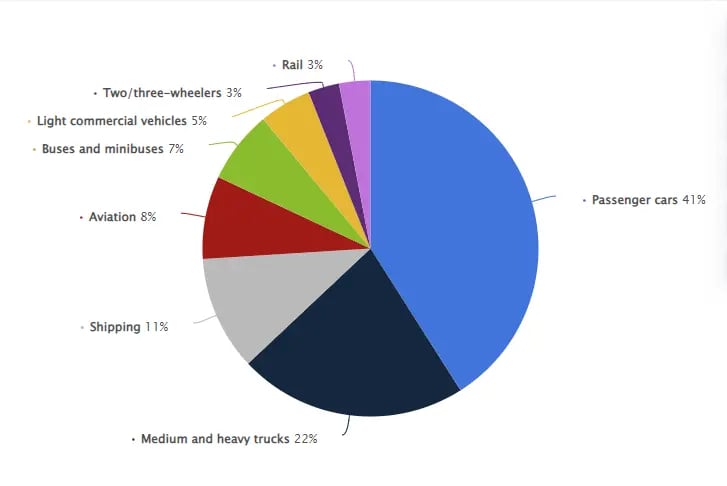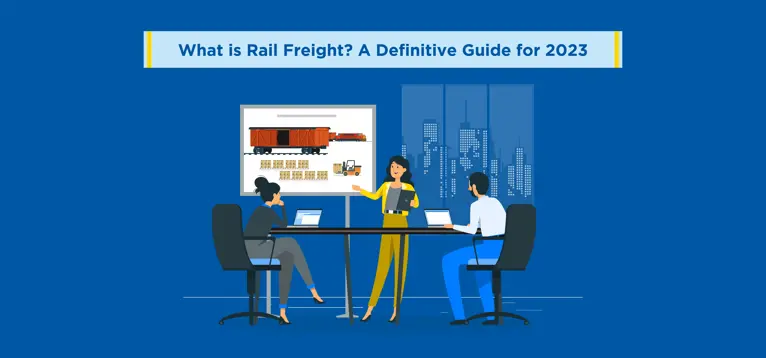Did you know rail freight is one of the freight transport modes with the lowest greenhouse gas emissions?
While the global transportation sector emerged as the major polluter in 2020 and generated around 7.3 billion metric tons of carbon dioxide (CO2) emissions, rail freight accounted for only 3% of the total transportation emission.

Besides that, rail freight forwarding is an efficient way to move bulk cargo over the vast network of rail tracks.
Thus, any business that needs efficient mobility for its bulk material is a great candidate to employ rail freight in its supply chain.
This article focuses on helping businesses understand the fundamentals of rail freight shipping and its value in their logistic strategy.
What is Rail Freight?
Rail freight is the usage of trains and railroads to transport cargo over land between the shipper and the intended destination.
Rail freight trains are dedicated to cargo transportation and differ from passenger trains. They can carry any freight, from raw materials to cars to furniture. Moreover, train wagons
are specifically designed for different types of goods, allowing them to move across domestic and international borders via rail.
So, when is rail freight service a good alternative for your business?
- While moving cargo from inland to port facilities.
- When large volumes of freight are moved in bulk.
- Shipping bulk raw materials such as metal ore, coal, and farm grains.
- For high-speed delivery over extensive distances.
- When a customer demands an exact delivery time.
- If you need an eco-friendly alternative to road freight
What is the Weight Limit While Shipping via Rail Freight?
The average cargo-carrying capacity of a single train wagon or car used for hauling freight is around 125 tons. With 100 wagons or more, the total weight carrying capacity of the train is well higher than 12,500 tons.
Factors That Determine the Rail Freight Costs
As with other modes of transport, the choice of rail depends on the fine balance between safety, price, and speed.
With its low fuel cost, rail freight is a cost-effective freight option. It is also more lucrative when large or awkward cargo is to be shipped in bulk. Nonetheless, it simply doesn’t make sense when it comes to low-volume, high-value commodities that are better transported via air freight.
To help you plan rail freight forwarding for your products, let’s talk about the factors affecting the rail freight rates:
- Distance: Rail freight shipping tends to be less expensive over longer distances.
- Dimensions: It includes the weight and size of the cargo transported.
- Pick-up and delivery locations: Additional road transport is required to move cargo from or to the railway corridors.
- Nature of the goods: Whether shipping toxic, fragile, flammable or hazardous goods.
- Insurance coverage: Depending on the cargo type, additional protection can be provided.
- Custom clearance fees: For cargo crossing borders, customs charges may apply.
In addition, a combination of other aspects—geographical location, wagon used for transportation, type of freight service—get reflected in the final rail freight rates.
What Are the General Categories of Rail Freight Services?
Unit Trains
It’s a dedicated train in which all cars carry a single cargo from a customer. It operates in a continuous shuttle without being split up during the journey. This type is especially efficient and affordable for high-volume commodities.
Another great thing about them is that they run between two fixed destinations on a fixed schedule, saving you a lot of time and money.
Mixed Freight
Mixed freight trains move numerous cars and cargo from shippers. For the same reason, it does not move as smoothly as unit trains from one point to another.
To limit additional costs of individual switching and handling of cars, they are generally blocked in groups that can be switched together with minimum handling en route.
But in case there are insufficient cars ready to travel, they will be held in a queue until the block is cost-effective enough to travel, delaying the delivery of other cars.
Intermodal Freight
The method involves freight movement on land using rail and road modes. Intermodal trains either carry containers or road trailers. The freight covers the major transportation haul on the railroad, followed by road freight using trucks to reach its final destination.
It’s more fuel-efficient and economical than long-haul road freight, reducing the total shipment cost by 10 to 15%. In addition, it is more desirable for shippers to want to reduce their carbon footprint.
Advantages of Rail Freight
1. High Average Speed
Businesses can significantly reduce the lead time by shrinking transport time. Sure, rail freight is slower than air freight. But with a high average speed of about 80 to 480 kmph, rail freight manages to realise shorter lead times than sea freight.
It is favourable for the fast-moving consumer goods industry, for which high demands and short delivery times are notable characteristics. Besides, shorter lead times are extremely convenient for businesses to forecast operations and costs, better manage their inventory, and have beneficial capital allocation.
2. Environmental Sustainability
Rail is more fuel-efficient and eco-friendly freight transport than planes and trucks. Thus, rail freight reduces energy consumption and environmental impact during transport.
Moreover, there has been a steady rise in the use of electrified and solar-powered trains in freight activities in recent times. Thus, rail freight holds the promise of displacing more emission-intensive forms of freight in the near future.
3. Reliable Transit Times and Schedule
While there can be occasional delays, rail freight is generally a punctual mode of transport. Unlike road and sea freight, which are plagued by congestion and weather dependency, rail freight schedules are not adversely affected by such issues. It minimises the risk of sudden hold-ups and potential downtime.
4. Cost-efficiency
Rails tend to transport freight more efficiently—one train can haul the cargo equivalent to over 400 trucks. Because of this, rail freight deliveries turn out to be cost-effective.
It is even more prominent with electrically-powered freight trains as it enables you to avoid annoying fuel surcharges and oil price fluctuations.
Businesses can channel the saved money to cover extra costs, positively impacting the overall cost parameters and capital binding.
5. High Level of Safety
Although rail has a pretty good safety record, private and public sectors worldwide have continually adopted innovative technology to enhance freight train security over the past decades.
There is ongoing investment in railway infrastructure, secure storage areas for hazardous materials, advanced locomotive signalling systems, GPS tracking, remote video surveillance equipment, emergency-response protocols, etc.
All this has ultimately led to significant improvements in overall rail freight safety and reduced the impact of accidental and intentional freight accidents.
Having said that, rail freight suffers some weaknesses too.
With rail tracks, end-to-end transportation is difficult to attain, requiring shippers to transfer cargo from the rail network onto another transport means. This, known as transshipment, often incur extra cost and time for short-distance freight transportation.
Conclusion
Despite all the advantages that rail freight transport endows upon businesses, some challenges are still associated with its logistics. And that’s when there is an opportunity to turn to a reliable freight shipping service for help.
If you would like PACK & SEND experts to help you through your freight shipping requirements, please do not hesitate to reach out.
Image Sources: Statista
